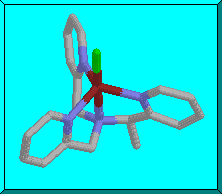| [Molecules: 9] [Related articles/posters: 063 024 060 001 010 ] |
We recently designed and synthezised a series of pseudo-C3-symmetric complexes with Cu(II) and Zn(II) that present a propeller-like asymmetry controlled dynamically by the absolute configuration at a single carbon atom in one of the arms. Molecular modeling of the complexes indicated that of all the possible conformers, only two contribute significantly, one of them being preferred in ratios of better than 7 to 1 (depending on the substitution and the nature of the heterocyclic ligand arms). In all cases the preferred conformation orients the substituent in the a carbon anti to the rest of the ligand, so an absolute configuration of "R" will give a lambda propeller (left handed twist). This conformational behavior has been observed in the solid state and in solution by X-ray crystallography and chiroptical methods.
|
 Perspective view of the complex [Zn(R-a-MeTPA)Cl]ClO4] |
|
|
![[Send e-mail to author]](email.gif) [jesus@canarylab.chem.nyu.edu].
Last Updated: Saturday, June 01, 1996
[jesus@canarylab.chem.nyu.edu].
Last Updated: Saturday, June 01, 1996